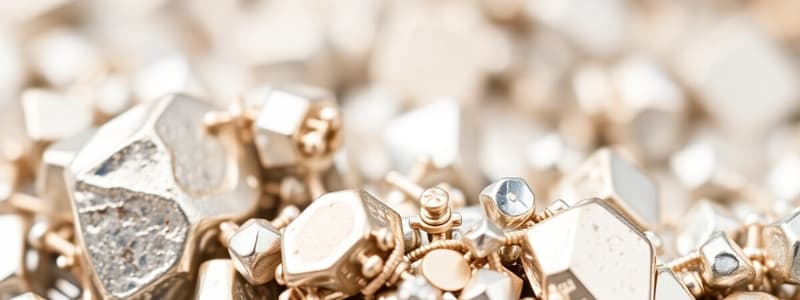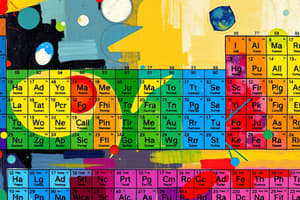Podcast
Questions and Answers
What are atoms?
What are atoms?
The smallest building blocks of all matter.
Elements are substances that are made up of how many types of atoms?
Elements are substances that are made up of how many types of atoms?
- Two types
- Many types
- One type (correct)
- No types
Each chemical element is identified with a unique atomic number.
Each chemical element is identified with a unique atomic number.
True (A)
Which of the following is a property of metallic elements?
Which of the following is a property of metallic elements?
What type of matter can non-metals exist as at room temperature?
What type of matter can non-metals exist as at room temperature?
What is a monoatomic element?
What is a monoatomic element?
What describes a molecular element?
What describes a molecular element?
Elements that consist of individual atoms are called ______ elements.
Elements that consist of individual atoms are called ______ elements.
How many known elements exist?
How many known elements exist?
Which of the following elements is non-metallic?
Which of the following elements is non-metallic?
Flashcards are hidden until you start studying
Study Notes
Elements
- Elements are pure substances made of only one type of atom
- All atoms in an element are identical
- Elements cannot be broken down into simpler substances
- Elements are classified into metallic and non-metallic elements
Metallic Elements
- Metallic elements possess characteristics like shininess, being solid at room temperature (except mercury), good conductors of heat and electricity, malleability, and ductility
Non-Metallic Elements
- Non-metallic elements are not shiny, can be solid or gas at room temperature (except bromine, which is liquid), are insulators of heat and electricity, and are brittle
- Some non-metallic elements have unique properties like water
Properties of Elements
- Elements can exist as individual atoms or molecules
- The arrangement of atoms determines the physical properties of an element, such as state of matter, melting and boiling points, conductivity, and strength
Monoatomic Elements
- Monoatomic elements consist of individual atoms
- Examples are Neon (Ne), Argon (Ar), Krypton (Kr), Xenon (Xe), and Radon (Ra), which are non-metallic gases
Molecular Elements
- Molecular elements are formed by clusters of two or more atoms bonded together
- All molecules in a molecular element are identical with the same size, shape, number, and type of atoms
Atomic and Molecular Elements
- If a substance contains only one type of atom, it's an element
- If an element consists of individual atoms, it's an atomic element
- If an element consists of more than one atom bonded together, it's a molecular element
Crystal Lattices
- Crystal lattices are large grid-like structures
- All metallic elements form crystal lattices
- Only a few non-metals form lattices
Metallic Lattice Structure
- Atoms in metals form lattices
- The lattice structure makes metals dense, strong, and solid at room temperature
- Atoms in metallic lattices can slide and move without breaking the lattice, making them malleable and ductile
Periodic Table
- There are 118 known elements, 98 of which occur naturally
- Each element has a unique name and chemical symbol
Atomic Number
- The atomic number of an element identifies it uniquely and is equal to the number of protons in its nucleus
Importance of Symbols and Formulas
- Using symbols and formulas for elements and compounds makes scientific communication clearer and more accurate
Studying That Suits You
Use AI to generate personalized quizzes and flashcards to suit your learning preferences.




